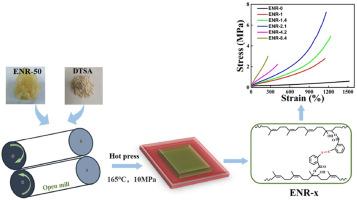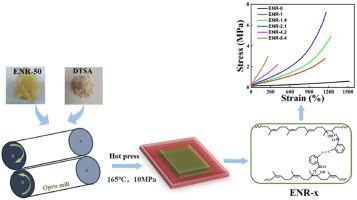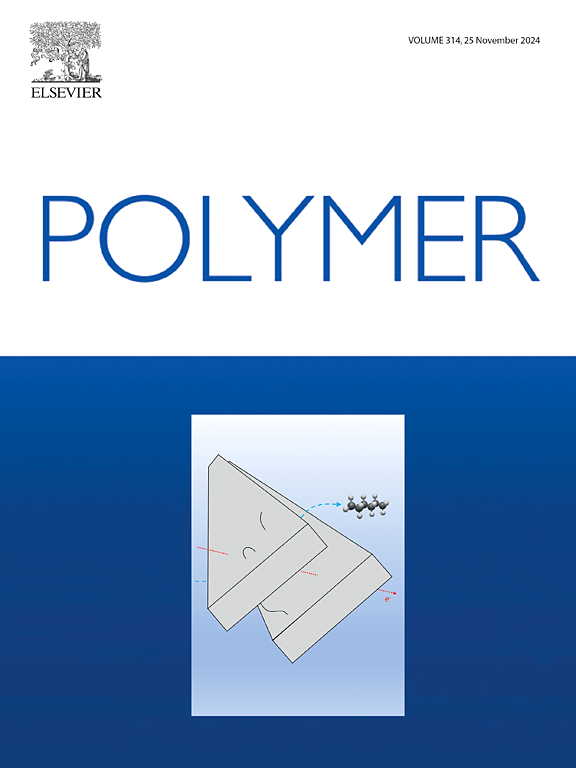一步法制备高伸缩性二硫化物交联环氧化天然橡胶
IF 4.1
2区 化学
Q2 POLYMER SCIENCE
引用次数: 0
摘要
二硫键在制备可回收橡胶方面具有独特的优势,因为它不仅显示出与传统硫化橡胶体系交联物相似的硫结构,而且还能在温和的外部条件下重新排列和交换。然而,已报道的二硫键交联橡胶往往由于二硫键含量不合适而表现出拉伸强度弱或伸长率低的问题。虽然一些含有二硫键的双交联橡胶能兼具良好的拉伸强度和较高的伸长率,但双交联设计总是需要在溶剂中进行多步化学改性,这对于工业操作来说既复杂又困难。本研究采用简单的一步法,在环氧化天然橡胶(ENR)中引入芳香族二硫键作为硫化剂。研究发现,当加入 2.1 phr 的 2,2'-二硫代水杨酸时,橡胶的伸长率可超过 1100%,拉伸强度可达 7MPa。系统研究了芳香族二硫键含量与 ENR 力学性能之间的定量关系,以及二硫键的交换行为。该研究成果不仅为制备易于工业化操作且具有高拉伸性的橡胶提供了一条简便的途径,而且有助于深入理解二硫键的作用机理。本文章由计算机程序翻译,如有差异,请以英文原文为准。


A highly stretchable disulfide-crosslinked epoxidized natural rubber by one-step method
Disulfide bond has unique advantages in the preparation of recyclable rubbers since it not only shows similar sulfur structure to the crosslinks of traditional sulfide rubber systems but also can rearrange and exchange itself under mild external conditions. However, the reported disulfide bond-crosslinked rubbers often exhibit weak tensile strength or poor elongation because of the inappropriate disulfide bond content. Although some disulfide bond incorporated dual-crosslinked rubbers can combine good tensile strength with high elongation, the dual-crosslinked design always requires multi-step chemical modification in the solvent, which is complex and difficult for industrial operation. In this work, aromatic disulfide bonds are introduced into epoxidized natural rubber (ENR) as the vulcanizing agent by a simple one-step method. It is found that the elongation of rubbers can be more than 1100 % with the tensile strength up to 7 MPa when 2.1 phr of 2,2′-dithiosalicylic acid is added. The quantitative relationship between the content of aromatic disulfide bonds and the mechanical properties of ENR is systematically studied, as well as the exchangeable behaviors of disulfide bonds. The research results of this work will not only provide a facile route for preparing rubbers with easily industrial operation and high stretchability, but also contribute to the in-depth understanding of the mechanism of disulfide bonds.
求助全文
通过发布文献求助,成功后即可免费获取论文全文。
去求助
来源期刊

Polymer
化学-高分子科学
CiteScore
7.90
自引率
8.70%
发文量
959
审稿时长
32 days
期刊介绍:
Polymer is an interdisciplinary journal dedicated to publishing innovative and significant advances in Polymer Physics, Chemistry and Technology. We welcome submissions on polymer hybrids, nanocomposites, characterisation and self-assembly. Polymer also publishes work on the technological application of polymers in energy and optoelectronics.
The main scope is covered but not limited to the following core areas:
Polymer Materials
Nanocomposites and hybrid nanomaterials
Polymer blends, films, fibres, networks and porous materials
Physical Characterization
Characterisation, modelling and simulation* of molecular and materials properties in bulk, solution, and thin films
Polymer Engineering
Advanced multiscale processing methods
Polymer Synthesis, Modification and Self-assembly
Including designer polymer architectures, mechanisms and kinetics, and supramolecular polymerization
Technological Applications
Polymers for energy generation and storage
Polymer membranes for separation technology
Polymers for opto- and microelectronics.
 求助内容:
求助内容: 应助结果提醒方式:
应助结果提醒方式:


